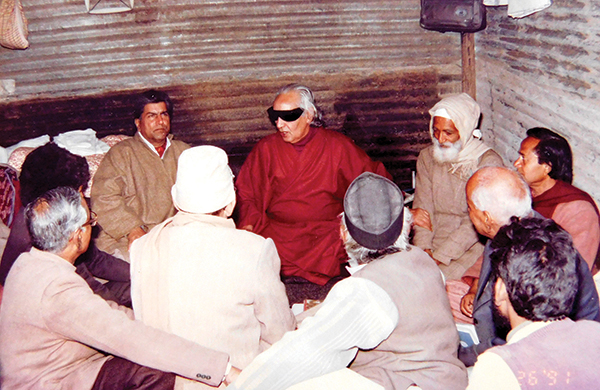As India begins the commemoration of the 150th year of Mahatma Gandhi’s birth celebrations, it is worth going down memory lane to recall the time Swami Rama spent with Gandhiji.
Bhole (as Swami Rama was known in his youth) asked his master the reason why Gandhiji was called a mahatma. His master took him to a railway station where Gandhiji was coming by train. A huge crowd had gathered to receive him. He and his master hid themselves in one of the rooms and his master asked him to observe Gandhiji minutely, how he walked, etc. When the train came and Gandhiji got down and walked, Swamiji realized that Gandhiji walked as though separate from his body. He seemed to be pulling his body as a horse pulls a cart.
It was late 30s and early 40s when Bhole visited Gandhiji at his ashram in Wardha. When there, Bhole observed how Mahatma Gandhi served a leper, personally looking after him with great care and love. The way Gandhiji served the sick left a lasting impression on Bhole. He says in Living with the Himalayan Masters, “A pioneer in the realm of ahimsa consciousness, Gandhi always experimented in expanding man’s capacity to love. Such a man finds joy in all the storms and trails of life. Gandhi never protected himself, but rather always protected this one principle of ahimsa or love. The flame of love burned in him day and night like a fire which nothing could quench. Complete self-reliance and fearlessness were the foundation stones of Gandhi’s philosophy. Violence touched the very depths of his being, but valiant in a spirit of ahimsa, he walked on alone. There was not a word of protest, and there was not a flicker of hostility in his life.” And before Bhole left the ashram, Gandhiji entrusted some ashramites under his care, whom Bhole took care till the end.
I myself had come to Swamiji with the inner desire to have a teacher who would enable me to realize the Lord within yet serve society outside. Though I did not explicitly state it so, he ensured that it happened thus. I’m sharing here some of the examples which reflect the spirit and action. I had grown up in a family that emphasized Gandhian thought of village development. When Swamiji asked me to do the rural work, part of the old grooming came up. For example, when I had to do up the office, I thought of floor seating with mattress and white sheets. He gently told me, “You are in a professional setting and you have to adjust yourself accordingly.” Yet, when it came to guidance for the work, Swamiji like Gandhi emphasized on working for the poor – to see that their basic necessities of food, clothing, medicine and education are met. The issue of cleanliness was also something that was common to both Swamiji and Gandhiji. Once he set up the hospital, Swamiji told the doctors, “Keeping the campus clean and green is my work, serving patients is your work.” Even when we were visiting sacred places with Swamiji, we were made to clean the surrounding areas and ensure that the place was spick and span. One lasting image in my mind is Swamiji by the Ganges, leading by example – having mala in one hand while picking up trash with the other! Yet he was practical too. During the early days of the hospital setup, we had an inauguration and all of us, from top to bottom, cleaned the entire building. I remember coming to him for an acknowledgment or praise and with gentle love he said, “It’s nice that you did it yourself, but learn to get things done!”
Once travelling through Kumaon region on work, I was told there was Gandhiji’s student’s ashram close by, so we stopped there. Sarla Ben (born Catherine Mary Heilman) was initially sent by Gandhiji to the Kumaon hillls for a year but she was so engrossed in the work with women and environment, that she requested permission from Gandhiji to stay there for the rest of her life. We were at her ashram. Sarla Ben took Bimala Behn under her wing and personally groomed her to carry on the work for women and ecology in the Himalayas. I met with Bimla Behn who married Sunderlal Bahuguna. He had met Swamiji at Uttarkashi along with his co-workers in the aftermath of Uttarkashi earthquake.
When the marriage proposal came up, Bimala Behn insisted that Sunderlalji, who was at that time Congress Secretary, leave everything to work in the interior villages. At that time he was very active in politics and in communication with Gandhiji and Sardar Patelji. He had the rare fortune of having a one to one meeting with Gandhiji a day prior to his death. Subsequently he left the political arena and the couple stayed in the interiors of Tehri region for many years and subsisted on what was provided for by the villagers. I presented her Swamiji’s book Living with Himalayan Masters. She took it reverently, flipped over its contents and photographs and then told us that Sarla Ben emphasized their schooling to happen in mother tongue and thus did not teach them English. When I told we also had a Hindi version of the book, she gave the English one back so that it could be used for others.
As part of celebration of RDI Founders Day, I gave her the calendar and diary. With a twinkle in her eyes she said, “I now have a calendar for next year!” Sunderlal Bahugunaji blessed us saying, “You all are young. Use your head (intelligence), heart and hands in the service of humanity!”
As part of Founders Day, three long standing disciples of Swamiji were also felicitated who espoused Gandhian and Swamiji’s way of living and being.
B. Maithili, Director, Rural Development Institute

